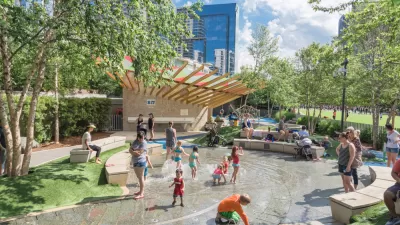Paris represents the best of grand architecture and city planning, from the Eiffel Tower to the Champs-Elysées. Yet, underneath these places, are small parks that bring together Paris' diverse populations through the power of play.
Paris is a city of grand projects. Its landmarks—the Eiffel Tower, the Champs-Elysées, and Notre Dame cathedral—are massive public works of the grandest order. Designed by Frank Gehry, the newest museum in Paris cost $130 million and, while it is a private venture of the Fondation Louis Vuitton, it’s indicative of the scale of this market. That “pop-up beach” on the banks of the Seine each summer? Price tag: $2 million.
That’s why it was so gratifying to see, on a visit to Paris last year, a fantastic urban project that cost the city very little, but has produced big results. The Place de la République is one of the city’s most beloved public squares, presided over by a colossal statue of Marianne, the symbol of the French Republic. (This statue was in the news recently, serving as the gathering place for those who marched after the Charlie Hebdo shootings.) The square, historically important as a place of protests large and small, has gone through several iterations in the last century and a half. For much of that time, it was a busy traffic circle with isolated park benches and walkways only reachable by dodging cars and motorcycles. In 2013, the city completed a costly renovation of the square, shifting the balance from two-thirds roadways to two-thirds pedestrian space. Cars have been pushed out to the edges of the three sides, with the rest as pavement interrupted only by benches, trees, and, of course, a cafe.
That sounds rather barren, but it is anything but. The architecture firm TVK wanted to preserve the full use of the square’s acreage without disrupting traffic flow or preventing groups from gathering under Marianne’s raised olive branch. The new square includes an attractive glass-walled cafe and an inviting “fountain,” where kids are free to play or ride bikes through the half inch of water covering the paving stones. In the evenings, the water is turned off, opening the space for strolling and weekend dances. The other side of the long square is a favorite place for skateboarding, which is wildly popular in Paris at the moment. The square is also wide enough to accommodate flâneurs, cyclists, or those hurrying to the underground République Métro station below the square.
FULL STORY: The Power of Play in the Public Square

Planetizen Federal Action Tracker
A weekly monitor of how Trump’s orders and actions are impacting planners and planning in America.

Maui's Vacation Rental Debate Turns Ugly
Verbal attacks, misinformation campaigns and fistfights plague a high-stakes debate to convert thousands of vacation rentals into long-term housing.

San Francisco Suspends Traffic Calming Amidst Record Deaths
Citing “a challenging fiscal landscape,” the city will cease the program on the heels of 42 traffic deaths, including 24 pedestrians.

Amtrak Rolls Out New Orleans to Alabama “Mardi Gras” Train
The new service will operate morning and evening departures between Mobile and New Orleans.

The Subversive Car-Free Guide to Trump's Great American Road Trip
Car-free ways to access Chicagoland’s best tourist attractions.

San Antonio and Austin are Fusing Into one Massive Megaregion
The region spanning the two central Texas cities is growing fast, posing challenges for local infrastructure and water supplies.
Urban Design for Planners 1: Software Tools
This six-course series explores essential urban design concepts using open source software and equips planners with the tools they need to participate fully in the urban design process.
Planning for Universal Design
Learn the tools for implementing Universal Design in planning regulations.
Heyer Gruel & Associates PA
JM Goldson LLC
Custer County Colorado
City of Camden Redevelopment Agency
City of Astoria
Transportation Research & Education Center (TREC) at Portland State University
Jefferson Parish Government
Camden Redevelopment Agency
City of Claremont



























